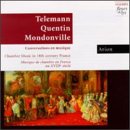| All Artists: Marin Marais, Jean-Joseph Cassanea de Mondonville, Georg Philipp Telemann, Alexandre de Villeneuve, Jean-Baptiste Quentin (le jeune), Arion Ensemble Title: Telemann, Quentin, Mondonville: Chamber Music in 18th Century France Members Wishing: 0 Total Copies: 0 Label: Analekta Release Date: 11/22/2006 Genre: Classical Styles: Chamber Music, Forms & Genres, Concertos, Historical Periods, Baroque (c.1600-1750), Classical (c.1770-1830), Instruments, Strings Number of Discs: 1 SwapaCD Credits: 1 UPC: 774204307820 |
Search - Marin Marais, Jean-Joseph Cassanea de Mondonville, Georg Philipp Telemann :: Telemann, Quentin, Mondonville: Chamber Music in 18th Century France
 | Marin Marais, Jean-Joseph Cassanea de Mondonville, Georg Philipp Telemann Telemann, Quentin, Mondonville: Chamber Music in 18th Century France Genre: Classical
|
Larger Image |
CD Details |
CD ReviewsConvincing artistic concept Leslie Richford | Selsingen, Lower Saxony | 07/23/2005 (5 out of 5 stars) "For many decades, French baroque music had the reputation of being "mannered" and therefore not worth listening to. It has only been through the efforts of the early music or period performance movement that this has been exposed as prejudice. The last 25 years or so have seen a process of rediscovery: theatre music (opera, secular cantatas), sacred music (masses, motets, lecons de ténèbres), solo instrumental music (for harpischord, lute, organ and even musette)and last but not least chamber music (suites, trio sonatas etc.). Among the most interesting ensembles to undertake exploratory forays in this last field have been the Canadian L'Ensemble Arion from Montreal. They published this, their fourth CD, in 1993 under the title "Conversations en musique", originally on the Atma label in Canada and on the Duchesnes world music label in Europe. The CD contains a collection of French chamber music pieces by Marin Marais (1692), Alexandre de Villeneuve (1733), Jean-Baptiste Quentin the Younger (1740), Jean-Joseph Cassanea de Mondonville (1734) and by the German all-round genius Georg Philipp Telemann, who is here represented by his "Concerto primo" from the collection of "Quatuors" which he published in Paris in 1733.
According to the concept behind the disc (musical conversation), the ensemble performs very homogenically. The pieces by Marais, Quentin and Telemann are performed by the whole ensemble, complemented by baroque cellist Susie Napper (well-known for her performances with Les Voix humaines). Although it is obvious that Claire Guimond takes a leading role on her wonderful-sounding baroque flute, you never get the feeling that there is any kind of competition between the instruments; rather, there is nothing here but harmony and co-operation, conversations en musique, with first the one, then another instrument taking the forefront. The gloriously recorded piece by Marais is a suite in the tradition of Lully and sounds, of course, rather old-fashioned in compariosn to the other pieces on the disc. The pieces by Quentin and Telemann show the development after French composers (and Telemann can be counted among these in a certain sense) had assimilated the influence of the Italian sonata. The two pieces by Villeneuve and Mondonville are duets. Villeneuves four-movement suite is written for flute and violin without basso continuo and gives both Claire Guimond and her colleague Chantal Rémillard the opportunity to show off their wonderful period instruments. In particular, I love the sound of Chantal Rémillard's baroque violin, built in 1650 by Antonio Mariani; that is certainly also the result of Ms. Rémillard's lovely playing which avoids any hardness and displays feminine sensibility throughout. This violin has a second opportunity to shine in the harpsichord sonata by Mondonville which the composer expressly instructed to be performed "avec accompagnement de violon?. Because of the music, this is certainly not a disc which is likely to send you into ecstacies on a first listening, but repeated close listenings will make plain the beauty of these pieces, the logic behind the artistic concept and the high standard of the musicians involved. " |

 Track Listings (22) - Disc #1
Track Listings (22) - Disc #1